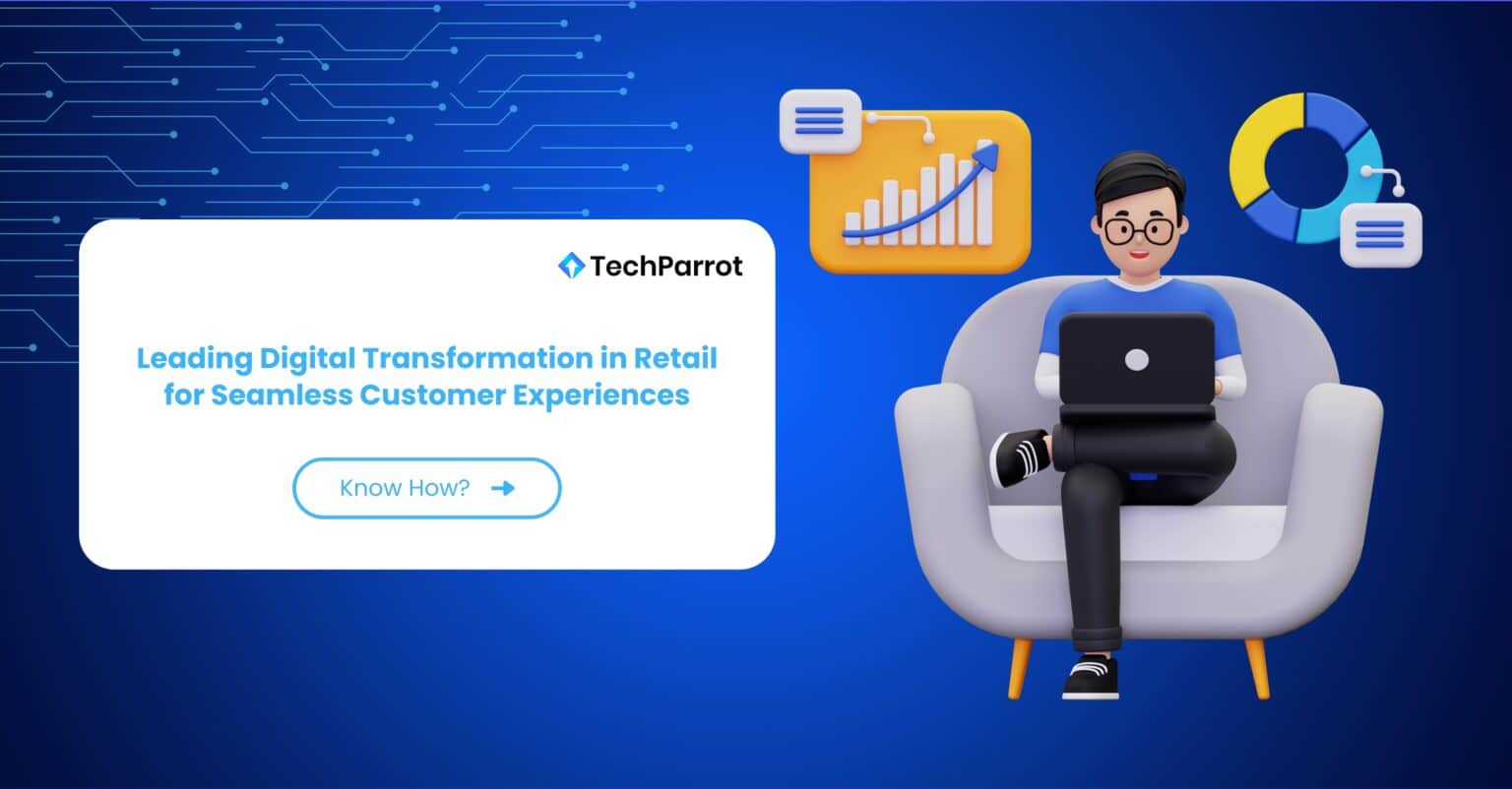As a CTO or technology leader in the retail industry, you are faced with the immense challenge of driving digital transformation while keeping customer experience at the forefront.
This blog is crafted specifically for tech leads like you, offering strategic insights on how Salesforce Commerce Cloud (SFCC) can be the cornerstone of your omnichannel strategy.
We’ll explore how SFCC’s powerful integrations, APIs, and data-driven capabilities can help you scale with digital transformation, enhance customer engagement, and improve operational efficiency. Whether you’re looking to improve personalization, streamline order management, or optimize for peak traffic periods, this guide has you covered.
Understanding Digital Transformation Goals
Let’s assume that you recently joined as a technology leader for a large retail chain like Walmart. You are given the mammoth task of digital transformation.
When it comes to large retail chains like Walmart beginning on a digital transformation journey, they focus on delivering seamless, omnichannel experiences to meet evolving customer demands.
For a retail company like yours, this meant integrating online and offline channels to provide customers with the flexibility to shop on any platform, at any time. Thus enhancing the customer journey by introducing features like curbside pickup, same-day delivery, and personalized online shopping recommendations.
Salesforce Commerce Cloud (SFCC) can align your digital transformation goals with enhancing customer experiences across digital touchpoints. By defining clear goals, such as improving conversion rates and streamlining supply chain processes, a retail brand can leverage SFCC to mirror Walmart’s success in achieving a comprehensive omnichannel presence.
The brand should assess its current capabilities and strategically plan how SFCC will support initiatives like faster product launches, improved data insights, and better engagement with customers across multiple channels.
Data Integration Strategy
As you move forward with integrating Salesforce Commerce Cloud (SFCC) into your digital transformation journey, a robust data integration strategy becomes critical. In a large retail chain like Walmart, the complexity arises from managing vast amounts of customer, product, and transactional data across multiple systems—both legacy and modern. Synchronizing this data in real-time ensures that every customer interaction, whether online or in-store, is consistent, personalized, and seamless.
To enable this, SFCC needs to be integrated with existing Enterprise Resource Planning (ERP), Customer Relationship Management (CRM), and Point of Sale (POS) systems.
These integrations allow the flow of key information—such as inventory levels, customer preferences, and purchase history—across all touchpoints.
For example, when a customer places an order online for in-store pickup, the system needs to immediately reflect accurate inventory levels in both the eCommerce platform and the store database.
As a technology leader, you’ll want to consider middleware or ETL tools to facilitate real-time data transfers between SFCC and internal systems. This ensures that no matter where your customers engage—whether it’s ordering online, picking up in-store, or using a mobile app—they receive consistent, up-to-date information.
Data governance is equally important in this strategy. Retail giants like Walmart often deal with highly sensitive data, from customer payment information to shopping habits. Establishing clear policies around data accuracy, privacy, and security will not only ensure compliance with regulations but also build trust with your customer base.
Use Cases for Digital Transformation in Retail Using Salesforce Commerce Cloud (SFCC) and APIs
Leveraging APIs, especially within Salesforce Commerce Cloud (SFCC), reduces time-to-market for launching new features and improves scalability by enabling faster, modular development and seamless system integrations.
APIs enable digital transformation in large retail chains by connecting Salesforce Commerce Cloud (SFCC) with other systems. Here are key use cases for integrating SFCC with APIs:
- Unified Customer Profiles Across Channels
Retail giants often struggle with maintaining consistent customer profiles across multiple platforms. Using APIs, SFCC can integrate with Customer Relationship Management (CRM) systems to create unified profiles that track customer behaviour and preferences in-store, online, and through mobile apps.
Using Salesforce’s Open Commerce API (OCAPI), you can integrate SFCC with a CRM to pull customer data, including purchase history, browsing behaviour, and preferences from various touchpoints.
The API allows for real-time syncing of customer profiles, ensuring updates from online purchases or in-store visits are reflected instantly. This unified data can then be leveraged to provide personalized shopping experiences, such as targeted product recommendations or tailored marketing emails, enhancing customer engagement and satisfaction.
- Faster Integration of New Payment Gateways
Retail giants can quickly integrate new payment options like Apple Pay, Google Pay, BNPL services (e.g., Klarna), and Stripe using payment gateway APIs, especially within platforms like Salesforce Commerce Cloud (SFCC).
These APIs reduce time-to-market from months to weeks by handling secure transactions, fraud prevention, and regional compliance without custom development.
Stripe plays a key role in SFCC for seamless integration across eCommerce and physical stores, supporting multiple payment methods, while ensuring security and global reach. This approach accelerates deployment and enhances customer experience efficiently.
- Rapid Deployment of Personalized Marketing Features
Retailers can use APIs to connect SFCC with analytics platforms, gaining insights into customer behaviour and optimizing their marketing strategies.
By using APIs from personalization platforms (such as Salesforce Einstein), a retailer can quickly roll out AI-driven product recommendations, dynamic pricing, or tailored marketing messages without a deep system overhaul.
New personalized features can be deployed within days, allowing the business to respond quickly to market trends or seasonal demand shifts while maintaining customer engagement through real-time recommendations.
- Seamless Scaling During Peak Traffic Periods
APIs allow SFCC to communicate with cloud infrastructure (such as AWS or Google Cloud) to auto-scale resources based on traffic demand. For example, APIs ensure real-time load balancing and resource allocation during Black Friday or holiday sales.
This scalability ensures the website or app can handle high-traffic loads without crashing or slowing down, allowing rapid feature rollouts even during high-traffic periods.
- Faster Multi-Channel Integration
A retail brand can quickly integrate a new mobile app or a third-party marketplace (like Amazon or eBay) into its existing SFCC ecosystem using APIs for product listings, inventory management, and order fulfilment.
New sales channels can be added and synchronized within weeks, speeding up the ability to capture new market segments without complex development efforts.
- Real-Time Inventory Management
APIs between SFCC and an Enterprise Resource Planning (ERP) or Warehouse Management System (WMS) allow real-time updates of inventory levels across various stores, warehouses, and the e-commerce platform.
This minimizes development time for custom integrations and enables faster updates for stock availability, reducing delays in feature rollouts like “Buy Online, Pick Up In-Store” (BOPIS) or “Ship from Store.”
- Order Management and Fulfillment
For large retailers, handling millions of orders daily requires an efficient, API-enabled order management system. SFCC’s APIs can integrate with existing ERP or third-party logistics (3PL) systems to automate order fulfilment and delivery.
Using the Open Commerce API (OCAPI), SFCC pushes order details to the Order Management System immediately after a transaction is completed, ensuring real-time processing. Additionally, integrating with shipping APIs allows automatic updates on shipping status, providing customers with real-time tracking information.
These APIs also trigger automated fulfilment processes, including warehouse picking, packing, and shipping, streamlining the entire order handling. Furthermore, APIs can support return and exchange management by enabling reverse logistics. This allows customers to initiate returns or exchanges seamlessly, offering a smooth post-purchase experience while improving operational efficiency.
__
In each case, APIs reduce the need for custom development, speed up testing and deployment cycles, and allow features to scale as the business grows, leading to faster innovation and smoother operations.
How to Decide if SFCC Integration is economically feasible
By now, you’re likely convinced of the power of Salesforce Commerce Cloud (SFCC). But what about convincing your colleagues, who may want to understand its economic feasibility?
In this section, we’ll discuss how to evaluate whether integrating SFCC is a cost-effective decision. We’ll outline the exact decision-making process we used to convince one of our clients—a legacy musical instrument company—highlighting the financial benefits, cost-saving opportunities, and long-term ROI that SFCC brings to the table.
- Boost in Conversion Rates and Customer Retention
In our pilot with the client, a leading musical instrument company, we discovered that the lack of an omnichannel experience was causing a significant loss of business due to poor user experience.
To address this, we provided personalized purchase recommendations based on browsing history and suggested complementary products, enhancing customer engagement.
Additionally, by leveraging predictive analytics, we enabled the client to send personalized emails recommending products that customers might need six months after their initial purchase, such as accessories, upgrades, or maintenance tools, driving long-term customer loyalty and repeat sales.
- Faster Deployment and Handling Load during peak season led to improved profit margins
Our client was facing challenges with scalability and handling peak season loads, especially during key periods like holiday sales and new product launches. Their old eCommerce platform struggled with slow deployments and downtime during high-traffic periods, leading to missed sales opportunities and frustrated customers. They were also incurring high development costs with each new feature rollout, which further hindered their growth.
Post integration with SFCC and improving the scalability and faster deployment with APIs, we calculated their savings during the peak holiday season. The ability to handle higher traffic loads without system crashes or performance slowdowns led to a 30% increase in revenue during their busiest time of year.
Additionally, the faster deployment cycles meant that they could release new features and updates quicker, reducing their development costs by 20%. Automation and improved scalability saved them significant operational costs, allowing them to reinvest those savings into marketing and product development, which further boosted their revenue.
Ultimately, the integration of SFCC led to a clear ROI, with a positive impact on both short-term sales and long-term growth.
Conclusion
Integrating Salesforce Commerce Cloud (SFCC) is more than a technological upgrade. It’s a transformative decision that drives business growth, improves customer satisfaction, and boosts operational efficiency.
By leveraging the power of APIs, retailers can deliver personalized experiences, scale operations seamlessly during peak seasons, and streamline order management. As seen with our client’s success, faster deployments, higher traffic capacity, and improved automation lead to significant cost savings and revenue growth.
The economic feasibility of SFCC lies not only in its immediate impact but also in its long-term return on investment, making it a key player in any digital transformation strategy.








